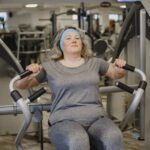Motor fitness refers to the ability of an individual to perform physical activities that require a combination of strength, flexibility, coordination, and balance. It plays a crucial role in overall health and wellness, impacting everything from daily movement to athletic performance. In this article, we will explore how exercise can improve motor fitness and why it’s important for individuals of all ages to prioritize physical activity for this purpose.
Having good motor fitness is not only beneficial for performing specific sports or activities but also for preventing injury and maintaining independence as we age. Research has shown that regular exercise can significantly enhance motor fitness, leading to improved functional abilities and overall quality of life.
This section aims to shed light on the impact of motor fitness on our physical well-being and set the stage for understanding the specific ways in which exercise can benefit our motor abilities.
Throughout this article, we will delve into the components of motor fitness, explain how exercise affects them, discuss different types of exercises for improvement, explore the benefits that come with enhanced motor fitness, and provide tips for designing a well-rounded exercise routine tailored toward building up these essential physical skills.
Stay tuned as we uncover the science behind using exercise as a tool to enhance motor fitness.
Understanding Motor Fitness
Motor fitness is a crucial aspect of physical health that encompasses various components, including strength, flexibility, coordination, and balance. These elements are essential for everyday movements, sports performance, and overall quality of life. Without adequate motor fitness, individuals may struggle with tasks such as carrying heavy objects, maintaining proper posture, or even walking without the risk of injury.
To improve your motor fitness, it’s important to engage in activities that specifically target these components. Some examples include:
- Strength training exercises: Weight lifting, resistance band workouts
- Flexibility-focused activities: Yoga, stretching routines
- Coordination and balance drills: Tai chi, Pilates, stability ball exercises
By incorporating these types of exercises into your fitness routine, you can enhance your motor fitness and reap the benefits in various aspects of your life.
Overall functionality is greatly influenced by an individual’s level of motor fitness. This means that improved motor fitness can lead to better athletic performance and reduced risk of injury during physical activities.
In a study published by the American College of Sports Medicine (ACSM), it was found that individuals who participated in regular exercise programs aimed at improving their motor fitness experienced a significant decrease in the occurrence of musculoskeletal injuries compared to those who did not engage in such programs. These findings highlight the importance of motor fitness for preventing injury and improving overall physical well-being.
How Exercise Affects Motor Fitness
Exercise plays a crucial role in improving motor fitness, which encompasses various components such as strength, flexibility, coordination, and balance. Through regular physical activity, individuals can enhance their motor fitness levels, leading to better overall movement and physical capabilities. One way that exercise affects motor fitness is by increasing muscle strength and endurance. Strength training exercises like weightlifting or resistance band workouts can target specific muscle groups, improving overall body strength.
Furthermore, engaging in activities such as yoga and Pilates can significantly impact flexibility and coordination. These types of exercises focus on body awareness, proper alignment, and controlled movements that directly contribute to enhanced motor fitness. Research studies have shown that practicing yoga or Pilates regularly can lead to improved balance and coordination skills as well.
In addition to strength training and mind-body exercises, aerobic activities like running, cycling, or swimming also contribute to improved motor fitness. Aerobic exercises help increase cardiovascular endurance while promoting overall body coordination and agility.
Incorporating a variety of exercise modalities into a fitness routine ensures the comprehensive development of motor fitness components. According to a study published in the Journal of Sports Sciences, individuals who engage in a combination of strength training, flexibility exercises, and aerobic activities experience greater improvements in motor fitness compared to those who only focus on one type of exercise.
| Motor Fitness Component | Exercises |
|---|---|
| Strength | Weightlifting, Resistance Band Workouts |
| Flexibility & Coordination | Yoga, Pilates |
| Aerobic Capacity & Agility | Running, Cycling, Swimming |
Types of Exercises for Motor Fitness Improvement
When it comes to improving motor fitness, incorporating a variety of exercises that target different components is key. A well-rounded exercise routine should include activities that focus on strength, flexibility, coordination, and balance. Here are some types of exercises that can help enhance motor fitness:
Strength training exercises, such as weightlifting or bodyweight exercises, are essential for building muscle strength and power. These types of exercises can improve overall motor fitness by increasing the body’s ability to perform physical tasks efficiently.
Both yoga and Pilates are excellent for improving flexibility, balance, and coordination. These mind-body practices also promote relaxation and stress reduction, which can positively impact motor fitness by enhancing overall well-being.
Agility drills involve quick changes in direction, acceleration, deceleration, and reaction time. By regularly incorporating agility drills into an exercise routine, individuals can improve their coordination and proprioception – the body’s ability to sense its position in space.
Overall, a combination of strength training, yoga/Pilates, and agility drills can significantly contribute to improved motor fitness. By targeting different components such as strength, flexibility, coordination, and balance with these exercises, individuals can enhance their physical capabilities and overall quality of life.
In the next section we will look at the benefits of improved motor fitness and how it can impact daily life.
Benefits of Improved Motor Fitness
Improved motor fitness can have a wide range of positive effects on an individual’s daily life. From enhanced athletic performance to a reduced risk of injury, the benefits of good motor fitness are significant. Let’s take a closer look at some of the advantages that come with improving motor fitness through regular exercise.
Enhanced Athletic Performance
One major benefit of improved motor fitness is the enhancement of athletic performance. Whether you’re an elite athlete or someone who simply enjoys recreational sports, having strong coordination, balance, and flexibility can greatly improve your overall performance. Activities such as running, jumping, throwing, and even basic movements like walking require good motor fitness, and by improving these skills through targeted exercises, athletes can see improvements in their speed, agility, and overall skill level.
Reduced Risk of Injury
Another significant benefit of improved motor fitness is the reduced risk of injury during physical activities. When your body is well-conditioned and has good balance and coordination, you are less likely to experience accidents or injuries while engaging in sports or everyday activities. For example, individuals with better balance are less likely to suffer from falls or trip over obstacles, while those with greater flexibility are less prone to muscle strains or tears during physical exertion.
Improved Quality of Life
Beyond athletic performance and injury prevention, improved motor fitness can also contribute to an overall improved quality of life. Individuals with good motor fitness often find it easier to perform daily tasks such as carrying groceries, climbing stairs, or playing with their children without feeling fatigued or experiencing discomfort.
Additionally, better coordination and balance can make activities such as dancing or gardening more enjoyable and accessible for people at all ages and stages in life. Overall, improved motor fitness leads to a more active, independent lifestyle free from many physical limitations.
Tips for Designing a Motor Fitness Exercise Routine
Designing an effective exercise routine to improve motor fitness is essential for achieving success in this area. Here are some tips for creating a well-rounded exercise plan that targets the different components of motor fitness:
– **Identify Your Goals:** Before starting any exercise routine, it’s important to identify your specific goals for improving motor fitness. Whether it’s to increase strength, enhance flexibility, or improve coordination, having clear objectives will help you tailor your workouts to meet those needs.
– **Incorporate Variety:** A diverse range of activities should be included in your exercise routine to address all aspects of motor fitness. This can include strength training for muscle development, yoga for flexibility, and agility drills for coordination and balance.
– **Balance Intensity and Rest:** It’s crucial to find the right balance between challenging yourself during workouts and allowing ample time for rest and recovery. Overtraining can lead to injuries and burnout, so scheduling rest days into your routine is essential.
– **Seek Professional Guidance:** If you’re new to exercise or have specific health concerns, consulting with a fitness professional or physical therapist can be beneficial. They can provide personalized recommendations based on your individual needs and limitations.
By following these tips, individuals can create an exercise routine that not only improves their motor fitness but also contributes to their overall health and well-being. Remember that consistency is key when it comes to seeing results, so stay committed to your routine and make adjustments as needed along the way.
Overcoming Barriers to Exercise for Motor Fitness Improvement
Many individuals face obstacles when trying to incorporate exercise into their routines to improve their motor fitness. One common barrier is lack of time, as people often have busy schedules with work, family, and other commitments.
Finding the motivation to exercise can also be a challenge, especially for those who may not enjoy physical activity or have struggled with consistency in the past. Additionally, some individuals may face physical limitations or health concerns that make it difficult to engage in certain types of exercise.
Despite these challenges, there are strategies that can help individuals overcome these barriers and stay on track with their motor fitness improvement goals. One approach is to prioritize time management and schedule exercise sessions as non-negotiable appointments.
This can help ensure that time for physical activity is built into one’s day. Another strategy is to find activities that are enjoyable and fulfilling, as this can increase motivation and make it more likely for individuals to stick with an exercise routine.
For those facing physical limitations or health concerns, it may be beneficial to work with a healthcare professional or certified fitness trainer who can provide guidance on safe and appropriate exercises. In some cases, modifications or adaptive equipment may be necessary to make certain activities accessible. It’s also important for individuals to set realistic goals and expectations when starting an exercise program, as doing too much too soon can lead to burnout or injury.
| Common Barriers | Strategies |
|---|---|
| Lack of time | Prioritize time management and schedule exercise sessions |
| Lack of motivation | Find enjoyable activities and build a support system for accountability |
| Physical limitations or health concerns | Work with healthcare professionals or adapt exercises as needed |
Conclusion
Exercise is a crucial factor in improving motor fitness. By engaging in regular physical activity, individuals can enhance their strength, flexibility, coordination, and balance. The benefits of improved motor fitness extend beyond just physical health, as they also contribute to overall wellness. With the incorporation of different types of exercises such as strength training, yoga, and agility drills, individuals can target specific components of motor fitness and experience a range of positive effects.
Research studies have supported the link between exercise and motor fitness improvement. For example, a study published in the Journal of Strength and Conditioning Research found that resistance training significantly increased muscle strength and power, contributing to better motor performance. Additionally, increased flexibility from activities like yoga has been linked to improved balance and coordination.
By prioritizing exercise for motor fitness improvement, individuals can experience various benefits in their daily lives. Enhanced motor fitness can lead to better athletic performance and reduce the risk of injuries during physical activities or sports. Moreover, it can also support greater independence in daily tasks for individuals of all ages.
Additional Resources for Further Learning
In conclusion, it is clear that exercise plays a critical role in improving motor fitness. By engaging in activities that target strength, flexibility, coordination, and balance, individuals can enhance their overall well-being and reduce the risk of injury. Scientific evidence supports the notion that regular exercise can lead to significant improvements in motor fitness, making it an essential component of a healthy lifestyle.
As we have seen throughout this article, there are various types of exercises that can be utilized to improve motor fitness, including strength training, yoga, Pilates, and agility drills. By incorporating a combination of these activities into a well-rounded exercise routine, individuals can experience the numerous benefits associated with improved motor fitness. From enhanced athletic performance to reduced risk of injury in daily life, the positive effects of prioritizing exercise for motor fitness improvement cannot be overstated.
In light of the information presented here, it is important for readers to recognize the value of exercise in improving motor fitness and take proactive steps to incorporate physical activity into their daily routine. By doing so, individuals can experience firsthand the positive impact that exercise can have on their motor fitness and overall quality of life.
Whether it’s overcoming barriers to exercise or designing a personalized workout regimen, prioritizing one’s physical well-being through regular exercise is an investment worth making.
Frequently Asked Questions
How Does Exercise Improve Motor Skills?
Exercise improves motor skills by promoting the development of muscle strength, coordination, balance, and flexibility. Engaging in physical activity helps to fine-tune motor control and precision, leading to improved dexterity and overall motor performance.
Whether it’s through aerobic exercises that enhance cardiovascular fitness or resistance training that builds muscular strength, regular exercise plays a crucial role in enhancing motor skills.
How Can I Improve My Motor Fitness?
There are several ways to improve motor fitness through exercise. Engaging in activities such as yoga, Pilates, dance, or tai chi can help improve balance, flexibility, and coordination.
Strength-training exercises using free weights or resistance bands can also contribute to better motor fitness by increasing muscle strength and endurance. Additionally, incorporating activities like walking, cycling, or swimming into your routine can enhance cardiovascular fitness, which is essential for overall motor fitness.
What Motor Fitness Is Enhanced by Exercise?
Exercise enhances a wide range of motor fitness components including agility, balance, coordination, power, reaction time, and speed. Physical activities that challenge these components such as sprinting for speed or practicing yoga for balance can directly enhance specific areas of motor fitness.
Overall, any form of exercise that promotes full-body movement and engages various muscle groups will contribute to the enhancement of motor fitness.

Passionate about providing useful information to anyone with an interest in the field of Personal Training, I strive to pass on to our readers quality information and to answer any questions about Personal Trainers, the work they do and how to become one.





